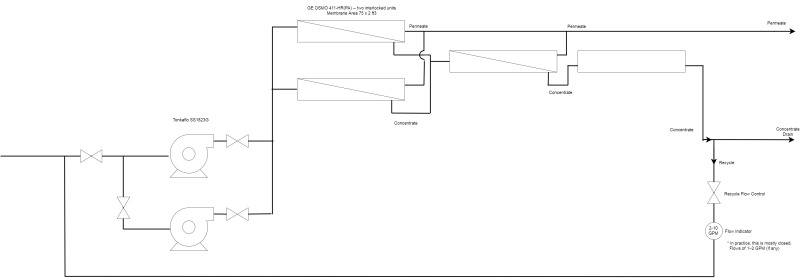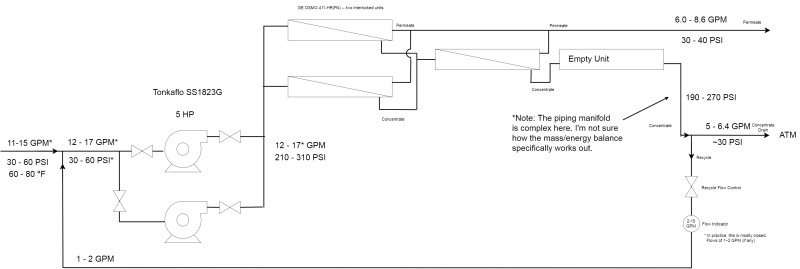ajz
Chemical
- May 8, 2017
- 8
Hello,
Hoping to find someone with a background or experience with RO systems to provide some input.
In brief, we have a RO system that we run in year round at 25% duty cycle. It filters municipal drinking water to a water quality suitable for injection into a gas turbine. Our operations staff is comfortable with the system operating at the 25% duty cycle, however we are experiencing duty cycle increase driven by two reasons: 1) INCREASED DEMAND - we have installed new equipment that draws RO water during the summer (50% increased demand -- call it 37.5% duty cycle). 2) DECLINING OUTPUT - As the changing seasons bring colder inlet water in the winter, the duty cycle factor can rise quite substantially (from 25% to 50% duty cycle in winter).
Thus, our operations staff has expressed desire to increase system output to keep that duty cycle lower.
Short of spec'ing and installing a new unit, I am looking for methods to increase this system's output. I have a few ideas, and was looking for...
[ul][li]input to confirm that an idea will/wont work[/li]
[li]a ballpark estimate of the magnitude of effect (e.g. 10% increase, 20% increase, etc.)[/li]
[/ul]
Here is a diagram of our system...

As you can see, it's a 2:1:1 configuration, however the 4th membrane sleeve DOES NOT have a membrane in it (i.e. we operate as a 2:1 configuration).
Additionally, the system has a "Recycle Flow Control" valve that diverts some of the concentrate back the the system intake.
My ideas:
[ul]
[li]Install a membrane in the 4th sleeve to gain an additional stage of filtration. I would guess that this would increase output by about 10-20% [/li]
[li]Play with the recycle knob. Could doing so increase output?[/li]
[/ul]
I recognize that installing the 4th stage comes at a consequence. The 4th stage will be filtering the greatest concentration of contaminants, and thus would be the first membrane to foul. Would we need to implement a membrane rotation schedule (i.e. put elements 3 and 4 in the positions of 1 and 2 every few months).
Can anybody offer input or recommendations on what to do?
Would it be ridiculous to consider preheating the inlet stream to maintain a relatively constant temperature so that we don't get the massive output drops in the winter time?
Here is a messy diagram that has some ranges of pressures and flows based on real world observation.

Hoping to find someone with a background or experience with RO systems to provide some input.
In brief, we have a RO system that we run in year round at 25% duty cycle. It filters municipal drinking water to a water quality suitable for injection into a gas turbine. Our operations staff is comfortable with the system operating at the 25% duty cycle, however we are experiencing duty cycle increase driven by two reasons: 1) INCREASED DEMAND - we have installed new equipment that draws RO water during the summer (50% increased demand -- call it 37.5% duty cycle). 2) DECLINING OUTPUT - As the changing seasons bring colder inlet water in the winter, the duty cycle factor can rise quite substantially (from 25% to 50% duty cycle in winter).
Thus, our operations staff has expressed desire to increase system output to keep that duty cycle lower.
Short of spec'ing and installing a new unit, I am looking for methods to increase this system's output. I have a few ideas, and was looking for...
[ul][li]input to confirm that an idea will/wont work[/li]
[li]a ballpark estimate of the magnitude of effect (e.g. 10% increase, 20% increase, etc.)[/li]
[/ul]
Here is a diagram of our system...

As you can see, it's a 2:1:1 configuration, however the 4th membrane sleeve DOES NOT have a membrane in it (i.e. we operate as a 2:1 configuration).
Additionally, the system has a "Recycle Flow Control" valve that diverts some of the concentrate back the the system intake.
My ideas:
[ul]
[li]Install a membrane in the 4th sleeve to gain an additional stage of filtration. I would guess that this would increase output by about 10-20% [/li]
[li]Play with the recycle knob. Could doing so increase output?[/li]
[/ul]
I recognize that installing the 4th stage comes at a consequence. The 4th stage will be filtering the greatest concentration of contaminants, and thus would be the first membrane to foul. Would we need to implement a membrane rotation schedule (i.e. put elements 3 and 4 in the positions of 1 and 2 every few months).
Can anybody offer input or recommendations on what to do?
Would it be ridiculous to consider preheating the inlet stream to maintain a relatively constant temperature so that we don't get the massive output drops in the winter time?
Here is a messy diagram that has some ranges of pressures and flows based on real world observation.

